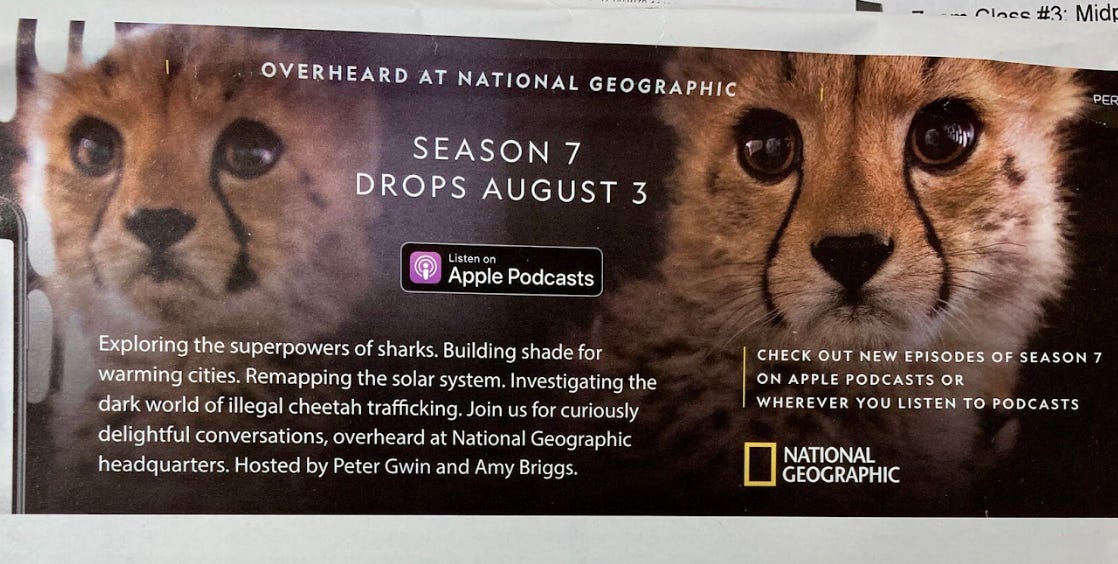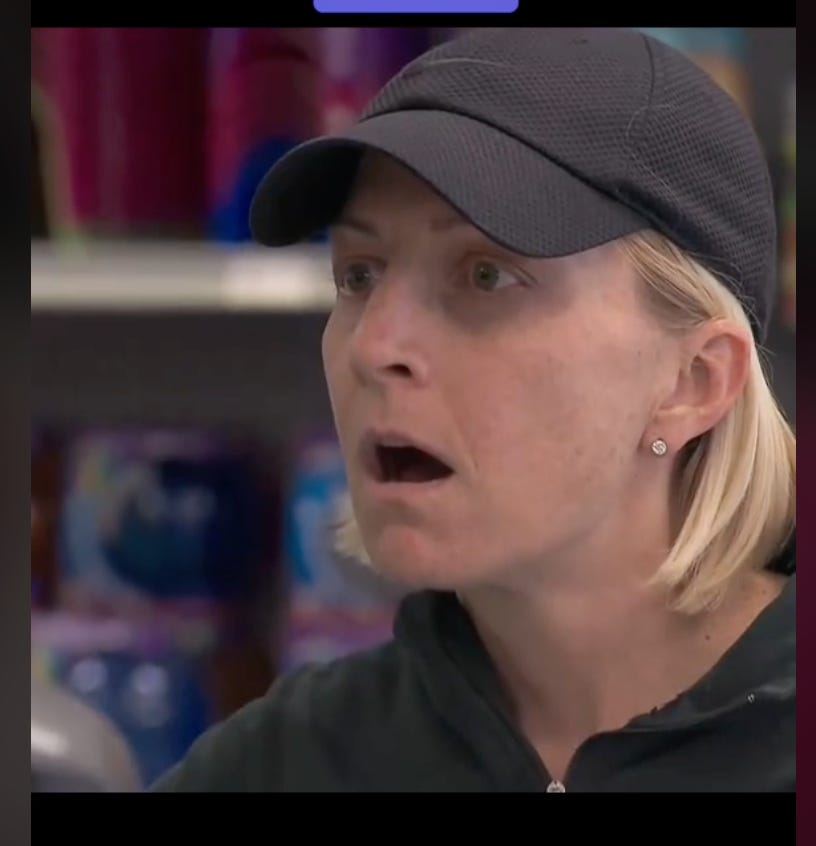This is How to Grow Your Audience
On reach vs effectiveness, measuring your marketing, and world-class Horse Water
Welcome to the Creativity Business, a newsletter about how to Earn Attention as a marketer or content creator. If you’re not a subscriber, sign up and get content strategy delivered to your inbox every two weeks for free.
We’ve already talked with Bumper’s Dan Misener about Marketing vs Marketability and Hard Work, Patience, and… Pec Implants. In this edition, we’re digging into strategies for growing audiences for your content.
Let’s start with the assumption that you’ve got a differentiated content strategy and you’ve put in the hard work to make something of high quality and high value to your intended audience. You feel confident that you’ve made something AWESOME.
Reach vs Effectiveness: You Must Choose
So what is the best way to let your audience know it exists? The first step is to decide what you want people in your desired audience to do - you have to focus on one thing only: getting them to sample your content.

Sampling doesn’t mean you’re trying to convince someone to wolf down a whole meal - it’s about getting them to have a little nibble. If they like the nibble, they will likely want more. Dan clearly recognizes the limits of what marketing can accomplish for content:
“The job of marketing is not to turn people into instant fans of a piece of content. I don't think marketing can do that.
“The job of any marketing for a piece of content is to get people to try it. I can't force you to listen to a podcast. I can't force you to buy a ticket to a movie. I can't force you to watch a streaming series. I can alert you to its existence. I can tell you where to go find it. I can tell you why it might be relevant to you and your life and the benefit you might get from it. But I can't force you.”
Recognizing that sampling is your desired end result is vital. A strong focus on sampling as a desired outcome will drive better marketing and more efficient audience growth.
“You can optimize a tune-in [sampling] campaign for one of two things. You can optimize for reach. You can optimize for effectiveness. And I wish it wasn't this way, but you kind of have to pick one. You can’t have both.
“So if the goal is to have the largest number of people hear an ad for the media product you're advertising, you can do that. A programmatic buy is a kind of ‘spray and pray’ approach where the goal is volume, volume, volume. Let's make our show unavoidable to listeners or viewers or readers of a certain media property. A programmatic buy is wonderful for that.”
In my opinion, ‘spray and pray’ is too often the default option because it’s obvious and relatively easy. Agencies can deal with one or two big networks, write a single cheque, and deliver a massive reach number to clients as a sign of success.
However, reaching a lot of people doesn’t mean that it will be an efficient use of your dollars, and it doesn’t guarantee that any of those people are going to be motivated to sample your amazing content.
If the only goal is sampling, you should consider optimizing for effectiveness instead of reach.
“I see far greater success when tune-in campaigns are optimized for effectiveness. How many impressions did I buy and how many converted devices did I get as a result of that campaign?”
When you optimize for effectiveness, different strategies emerge for growing audiences:
You don’t need to reach everyone - you need to reach exactly the right people.
You don’t need to be everywhere - you need to be where those people already are.
You don’t need ‘exposure’ alone - you need to have a compelling hook to get those people to actually sample. You need a marketable, differentiated show.
So what does optimizing for sampling effectiveness look like?
Owned Superpowers > Paid
For many companies, the single most effective way to grow audiences is in their own backyard. And while Dan’s examples are about growing podcast audiences, the lessons truly apply to any form of content - text, audio, or video.
“So often, people jump straight to paid [advertising] without thinking about what they already have in their toolkit. Brands especially have audience development superpowers that they may not even realize. And they may not have to pay for them!
“My favorite example of this is what Mozilla did with their podcast, IRL: Online Life is Real Life. They launched with some really smart, owned activations. Firefox is a popular web browser controlled by Mozilla. So for a period of time, when you opened up a new tab in Mozilla Firefox, you saw a search bar and the Firefox logo, and a wonderful little bit of marketing for the IRL podcast.”
The use of the Firefox browser was a key piece that led the IRL podcast to over 1 million downloads in it’s first seven-episode season.
“Another example. National Geographic has a wonderful podcast. They also have a print magazine. And when National Geographic, the print version, lands on some people's doorsteps, it's wrapped in an ad for their podcast.”
“Another example: Apple TV+. I watched the Foundation series on Apple TV+ and at the beginning of every single episode of Foundation, there was a title card advertising the companion podcast to Foundation.”
“I'm not saying it's no work to do these types of activations, but it's often a whole lot better bang for the buck than spending millions of dollars with an agency.”
Almost every company of a decent size has some sort of superpower, or at least a powerful owned channel. I highly recommend doing an owned channel audit. List all the ways you can reach people, the number of people reachable through each channel, and if possible, an order-of-magnitude conversion rate. A few obvious ones to start with:
Website (including navigation)
Other company content channels
Email newsletters
Blogs
Video series
Podcast series
Social media channels
Apps or in-product messaging
Product packaging
In-store/office/branch signage
Receipts and invoices you generate
Intranet
Staff email, Slack, Teams, etc
Company all-hands meetings
Your goals are to get people to sample the content and tell others about it. Make it as easy as possible to sample the content by eliminating unnecessary clicks and friction for first-time samplers. And make it easy for happy samplers to spread the word by providing shareable links with great content hooks.
You Need To Measure Your Marketing Effectiveness
So you’ve got your owned channels activated, especially if one of them is big enough to be a Superpower. You might have some paid promotion in market, too. You might be appearing as a guest on podcasts or writing guest columns for publications. And you might be using a lot of social media. And that means you’re probably starting to grow your audience.
If we’re optimizing for getting people to sample the content, we need to be able to tell what is driving sampling and what isn’t. So not only do you need to measure the effectiveness of your content at creating value for audiences, but you also need to measure the effectiveness of your marketing for growing the audience.
Marketing effectiveness can be defined as the number of people you tell about your content versus the number of people who take action and actually sample the content. The higher the percentage of people that sample, the more effective the marketing - you’re reaching the right people with the right message on the right channel.
For ‘spray and pray’ reach-focused campaigns, Dan sees order-of-magnitude benchmarks for driving podcast tune-ins.
“In my experience, when buying promos designed to encourage people to sample an original podcast, if a hundred people are exposed to my ad and it's really great, on the high end, one of those people might try what I'm selling. And on the low end, one in a thousand might sample my podcast.
“Conversely, if you're running a campaign that is super-targeted and reaching exactly the right people who are qualified to be interested in what you have to offer, you’ll get higher conversion rates, but it's hard to find scale there.”
Do marketers pay enough attention to the performance of their tune-in campaigns? Dan says “absolutely not.”
Most companies that spend on direct-response ads pay a lot of attention to their conversion rates. If they’re spending more than the ads are generating in revenue, they usually stop spending. This is the same mentality needed for marketing content.
“There is a quantification of results in that [direct response] world that I see sadly lacking in a lot of media marketing. And I think the most successful podcast marketers that I know have applied an awful lot of rigor, the same kind of rigor you might apply if you are measuring the effectiveness of a campaign designed to sell widgets.”
Depending on the type of content you’re producing, there are different attribution services that allow you to track marketing effectiveness. (Attribution services include bit.ly for broad social sharing, Hubspot for Content Marketing, Chartable for podcasting, and many, many others.) Even without attribution services, you can cobble together experiments to determine what works and what doesn’t for driving sampling.
For example, by isolating certain channels for specific time periods, you can generally see whether it has an outsized or undersized impact on growth. You might try a big promo on the home page of your website for a couple of days and even if you can’t measure click-through rates to the content, you should be able to see whether consumption was meaningfully shifted over those two days.
Launch vs In-Market Marketing Plans
There is one other big mindset shift required for effective audience growth - moving beyond a ‘launch mentality.’ Generally speaking, content creators tend to over-focus on launch and under-focus on episodic, series, and back-catalogue promotion.
“Rather than talking about the launch date for a podcast, I often try and steer clients to think about the in-market period. It's not a day we're building towards, it's three months we're working towards, or four months or six months that we're working towards. What is the in-market period? It's not just the launch that matters, it's the launch and every day that follows.”
Marketing beyond the launch isn’t just something that should be prioritized - it also needs to be resourced. Marketing your content is ongoing hard work and to do it well, you need resources in place.
“Every day in your marketing calendar that doesn't have something next to it is a day that you're saying, ‘I don't want people to find my show.’”
Again, audience growth is not about the launch. It’s about the series. It’s about the individual episodes. It’s about the guests that appear. It’s when something timely comes up that relates to a back-catalogue episode. It’s EVERYTHING.
“I think about how are we gonna market this series? How are we gonna market individual episodes? How do we market Game of Thrones, the series versus how do we market last night's episode of Game of Thrones or next week's episode of Game of Thrones? You have to do both.”
How’s Your Horse Water? Connecting All the Pieces
You know your goal for audience growth is sampling.
You’ve got an effectiveness-based mindset.
You’ve evaluated and activated your owned channels and Superpowers.
You’re measuring the effectiveness of each channel to drive sampling.
You’ve lined up resources and a plan to market the entire series, every episode or edition, and for the entire in-market period.
You have only more job to do. You need to find out if your new audience likes your content and wants more than the sample. You’ve led the horses to water. Are they ready do some drinking? For content, high-quality Horse Water is measured in time and attention.
“How do you know if you've made something worth people's time? Do people spend time with it? The answer to the question, ‘have we earned people's attention?’ can be measured, because if you're making something that is worth people's attention, they spend time with it.”
Almost any form of content has tools to measure time or consumption rate. Once you’ve got some samplers, are they going beyond sampling? If your samplers are consuming the vast majority of a podcast or a video, or if the majority of people are opening your emails, you’re creating value. If your audience continues to grow over time and people stick around for future content, you’re creating value.
The Full Plan
Before you start, research your content space and find out what already exists
Differentiate yourself with a unique content strategy (this ensures marketability)
Create an effectiveness-driven marketing strategy to grow your audience
Do an audit of your in-house channels and Superpowers for audience growth
Create an audience growth plan for the entire in-market period and not just launch.
Measure your marketing effectiveness and learn what drives audience growth
Measure the quality of your Horse Water - learn whether your audience goes beyond sampling to know if you’ve created something valuable
Big thanks to Mister Misener for sharing his thinking over the last three editions of this newsletter. If you want to keep up with Dan’s thinking and work, check him out at Bumper and the Bumper Blog.
What’s Earned My Attention Recently
Carbonaro Magic
This guy showed up on my TikTok feed recently and I honestly cannot get enough of what he’s putting out. He’s like Nathan Fielder mixed with David Blaine. He is doing real-world magic, but is filming it with hidden cameras and framing almost everything as an unusual business, product, or service. Watching people’s heads explode is as much fun as trying to figure out how he accomplishes all this.
Watch him compress live dogs for more efficient kennel storage and rejuvenate rotten food with magic tin foil.
Barbie - A New Era of Branded Content?
The Drum surveyed marketing leaders about whether the massive success of the Barbie Movie will drive a renaissance for brands as media companies. Short answer - YES!
Brands and Fan Culture
Here is some interesting new research about how brands can tap into fan culture.
What’s even more interesting is that the piece itself is branded content. It’s a Wall Street Journal custom content piece funded by Amazon Ads, promoting Amazon Ads’ Anatomy of Hype research. So branded content encouraging more branded content? Regardless of the source, tapping into fandom effectively is a big opportunity if done well.









